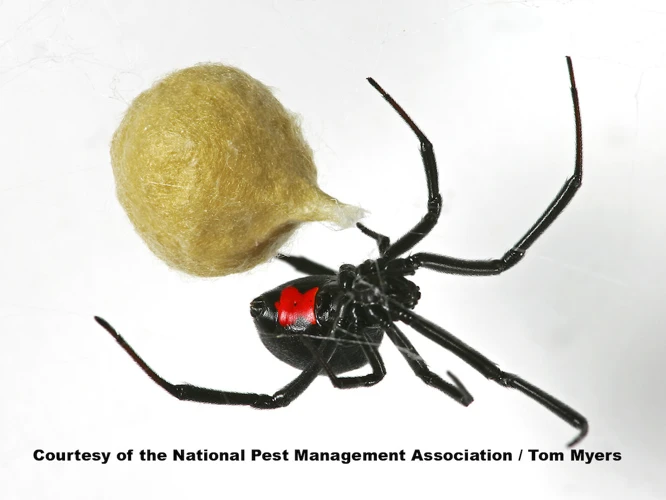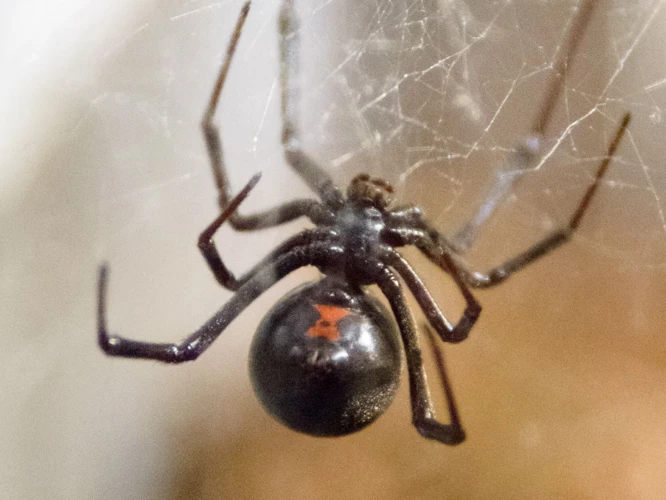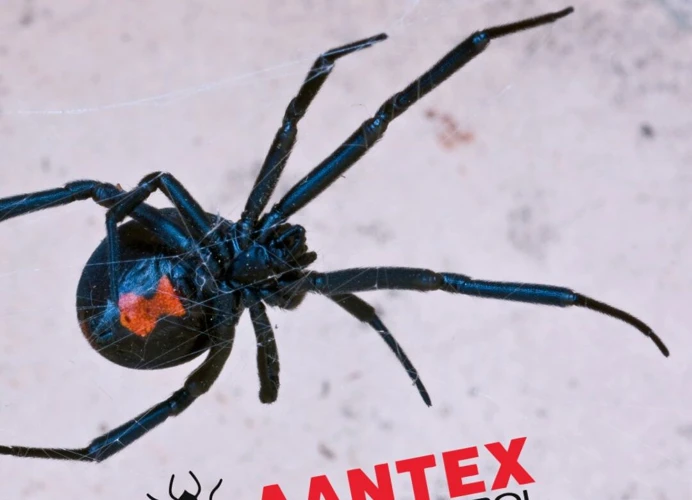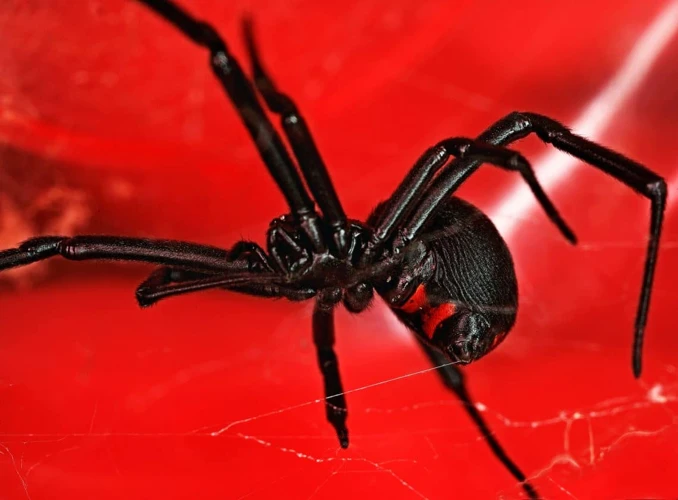As the days get colder and the desire for a cozy fireplace grows, many people turn to their trusty firewood piles for a source of warmth. However, the danger of black widow spiders hiding in those very piles should not be overlooked. These venomous arachnids have a tendency to seek shelter in dark, quiet places, making firewood piles the perfect spot for them to reside. Understanding the reasons behind their hiding habits and the potential danger they pose is crucial in taking necessary precautions to protect yourself and your loved ones.
Why Are Black Widow Spiders Hiding in Firewood Piles?

Have you ever wondered why black widow spiders are often found hiding in firewood piles? It may seem like an unusual spot to call home, but these spiders have their reasons. Understanding the behavior and tendencies of black widow spiders can help you protect yourself and your family from potential danger. In this section, we will explore the nesting habits and survival instincts of black widow spiders to shed light on why they seek refuge in firewood piles. If you want to learn more about common spots where black widow spiders are found, check out our article on common black widow spots.
Nesting Habits of Black Widow Spiders
Black widow spiders are known for their reclusive and often hidden behavior. They thrive in undisturbed areas like woodpiles, crevices, and corners. Female black widows display protective behavior towards their egg sacs and tend to nest in secluded and dark areas, where they won’t be disturbed.
According to black widow spider experts, female black widows build irregular webs that are messy in appearance and lack any specific pattern. These webs are usually found in hidden and dark areas such as under decks, eaves, and piles of firewood.
The nests of black widow spiders are silken, globe-shaped structures that can range from 0.5 to 2 inches in diameter. They are typically located in sheltered outdoor areas such as fences, vegetation, and woodpiles. These nests are usually not visible because of their location and the presence of debris around them.
Female black widows lay eggs in these nests and are fiercely protective of their offspring. They will attack anyone who comes close or poses a threat to their eggs. After hatching, the spiderlings remain under the mother’s care until they are old enough to fend for themselves. Once the young spiders mature, they disperse to find their own nesting area.
Black widow spiders tend to nest in dark and secluded areas like woodpiles, crevices, and under decks. Their irregular webs can be found in hidden areas and are often messy in appearance. The silken, globe-shaped nests of black widows can be found in sheltered outdoor areas like fences, vegetation, and woodpiles. The mother is fiercely protective towards her offspring and will attack any potential threats.
Survival Instincts of Black Widow Spiders
Black widow spiders are survival experts in many ways. These spiders are capable of adapting to various environments and climate conditions. They’re also efficient predators that are capable of hunting a wide range of insects by injecting potent venom into their prey. One of their most remarkable survival instincts is their ability to hide and wait for prey to come to them.
Black widow spiders are most commonly found hiding in dark, humid areas such as piles of firewood. They can wait patiently for days, or even weeks, for something to come within their range. One of the reasons they are so good at waiting is due to their ability to conserve energy. Black widow spiders have a slow metabolism, which allows them to survive for long periods of time without food or water. They can also stay dormant during the winter months, then emerge when temperatures rise and food becomes more abundant.
Another one of their survival instincts is their ability to produce silk. Black widow spiders use their silk to make egg sacs, create webs for catching prey, and create retreats where they can hide from predators. They are also known to create multiple retreats, so if one is compromised, they can quickly move to another one. When creating silk for their egg sacs, they use a denser weave than when creating webs for prey capture.
Black widow spiders are not only skilled hunters, but they’re also experts in evading predators. When they feel threatened, they use their silk to quickly retreat into their hiding spots. They can also scuttle away quickly, using their strong, agile legs to escape. If all else fails, black widow spiders will use their venomous bite to defend themselves.
It’s essential to keep in mind that black widow spiders should always be handled with care and respect. To learn more about how to stay safe from black widow spiders in your yard, check out our article on how to spot black widow spider webs, black widow spider risks during outdoor play, keeping black widows out of your garage, and how to find and remove black widow spider nests in your yard.
Why Are Black Widow Spiders a Danger to Humans?

Black widow spiders are not just creepy crawlers but also one of the most fearsome spiders found within the United States. Although their bites are not as deadly as many believe, they can still pose a significant threat to human health. Due to their venomous nature, black widow spiders are considered very dangerous to humans. Let’s explore the reasons behind this danger in more detail.
How Black Widow Spiders Bite
Black Widow spiders are known for their venomous bites, which can be extremely dangerous to humans. These spiders usually bite in self-defense when they feel threatened, but the bite can also occur accidentally. Understanding how their bites work can also help people understand the potential danger.
The Black Widow’s bite feels like a sharp pinprick and is often painless, making people unaware of the bite until symptoms appear. The spider has two fangs, which are chelicerae, and it uses them to inject venom into its victims. An interesting fact about these spiders is that their fangs are strong enough to penetrate human skin easily, even through clothes or shoes.
The venom from an adult Black Widow spider contains neurotoxins that affect a person’s nervous system, and a severe bite can cause death in children, elderly people, and those with weak immune systems. According to the National Geographic website, the black widow spider’s venom is fifteen times stronger than that of a rattlesnake!
To ensure that they can penetrate the victim’s skin and administer the venom, they have to position themselves correctly. Black widow spiders usually bite when pressed against a victim’s skin or when the skin gets squeezed by a piece of clothing or shoes.
| How Black Widows Bite Victims | The Dangers of Black Widow Spider Venom |
|---|---|
| Black widow spiders bite when pressed against a victim’s skin, or when squeezed by a piece of clothing or shoes. | The neurotoxins in a Black Widow spider’s venom can cause pain and muscle spasms. In severe cases, the venom can lead to death in children, the elderly, or people with compromised immune systems. |
| Black widow spiders bite using their two fangs, which are called chelicerae. | The venom from their bites is fifteen times stronger than that of a rattlesnake’s. |
If you are spending time outdoors or handling firewood, it’s important to take precautions against black widow spiders. By knowing how to spot their webs, juvenile black widow spider habits, and the risks associated with outdoor play, you can protect yourself and your family. It’s also a good idea to shake out any clothing or shoes before putting them on and inspecting any outdoor furniture for spider webs before use.
Common Symptoms of Black Widow Spider Bites
Black widow spider bites can be serious and even life-threatening, especially for young children, elderly individuals, and individuals with weakened immune systems. It is essential to recognize the symptoms of a bite to seek medical attention promptly. Common symptoms of a black widow spider bite include:
| Symptoms | Description |
|---|---|
| Pain | The affected area may feel painful, which may spread to other parts of the body. |
| Muscle cramps | The muscle cramps usually start within a few hours after the bite, and it can last for several days or weeks. |
| Sweating | The area around the bite may become sweaty, and the affected person may feel clammy. |
| Chills | The person may experience chills, fever, nausea, and vomiting. |
| Redness or swelling | The site of the bite may become red, swollen, and itchy. In some cases, the bitten area may turn blue or purple. |
| Abnormal heart rate | The person’s heart rate may become elevated, and they may experience an irregular heartbeat. |
| Weakened muscles | The person may experience weakness in the muscles, difficulty breathing, and paralysis. |
It is important to remember that not all black widow spider bites result in the same symptoms. Some bites may produce less severe symptoms, while others may be more severe. If you experience any of these symptoms after being bitten by a black widow spider, seek medical attention immediately. Black widow spiders can also hide in outdoor furniture, so it is essential to inspect and take necessary precautions to prevent bites from occurring.
How to Protect Yourself from Black Widow Spiders in Firewood Piles

As the weather turns colder, many people will begin stacking firewood in preparation for chilly winter nights. However, these seemingly innocuous piles of wood may be harboring a dangerous secret. Black widow spiders are known to be attracted to firewood, making stacks of logs a potential danger zone. Protecting yourself from these venomous creatures should be a top priority. Here are some important steps to take to safeguard yourself from black widow spiders in firewood piles.
Inspecting Firewood Piles
One of the most important steps in protecting yourself from black widow spiders in firewood piles is inspecting them carefully. Here is a table outlining some of the key things to look for when inspecting firewood piles:
| What to Look For | Why It’s Important |
|---|---|
| Visible webs or egg sacs | Indicates that black widow spiders may be present |
| Cracks or crevices in the wood | Provide hiding places for spiders |
| Dark corners or areas of the pile | Spiders like to hide in dark places |
| Presence of other insects or pests | Can attract black widow spiders as a source of food |
Once you have inspected the firewood pile and identified any potential risks, you can take steps to mitigate them and protect yourself. It’s also important to store firewood properly to reduce the likelihood of black widow spiders nesting in it. This means keeping the wood elevated off the ground and away from other potential habitats for spiders, such as piles of leaves or debris. By being vigilant and taking proactive measures to protect yourself, you can enjoy a warm fire without worrying about the risk of black widow spiders.
Wearing Protective Clothing
When inspecting firewood piles, it is important to take proper precautions to protect yourself from potential black widow spider bites. One of the most effective ways to protect yourself is by wearing appropriate protective clothing. Here are some clothing items that will help you avoid being bitten:
| Clothing Item | Importance |
|---|---|
| Long-sleeved shirts and pants | These clothing items will prevent spiders from coming into direct contact with your skin, reducing the risk of bites. |
| Gloves | Gloves will protect your hands and fingers from spider bites as well as any splinters or other debris that might be in the firewood pile. Make sure the gloves are durable, offer good grip and can resist bites. |
| Boots | Wearing boots instead of shoes will prevent spiders from crawling up your legs and biting. Look for boots that cover your ankles and make sure they are comfortable, sturdy and slip-resistant. |
| Face mask and goggles | If you are worried about spiders getting into your hair or eyes, a face mask and goggles will protect you. Make sure the mask can protect you from any breathed-in debris, dust or spiderwebs that may cause respiratory issues. |
It is important to note that simply wearing protective clothing is not a guarantee against black widow spider bites, but it can significantly reduce the risk. Additionally, make sure that the clothing you choose is loose-fitting, breathable, and comfortable enough for extended periods of firewood pile inspecting. Always remember to stay aware of your surrounding and be on the lookout for any signs of black widow spider activity; stay safe and stay vigilant.
Using Insecticides and Repellents
When it comes to protecting yourself from black widow spiders in firewood piles, using insecticides and repellents can be an effective approach. There are a variety of products on the market that are specifically designed to prevent spider bites, and you can choose the one that best suits your needs.
One option is to use an insecticide spray, which can be applied directly to the firewood pile. Look for a spray that is labeled as safe for outdoor use and specifically states that it is effective against black widow spiders. Be sure to read the label carefully and follow all instructions for use.
Another option is to use a spider repellent, such as peppermint oil or vinegar. These natural remedies can be mixed with water and sprayed onto the firewood pile or used as a soak for the wood. While there is limited scientific evidence to support the effectiveness of these remedies, many people have found them to be helpful in keeping spiders at bay.
It is important to note that using insecticides and repellents should not be your only line of defense. These products should be used in conjunction with regular inspections and proper protective clothing to ensure maximum safety.
Here is a table of some popular firewood insecticides and repellents:
| Product | Type | Active Ingredient(s) | Effectiveness |
|---|---|---|---|
| Ortho Home Defense Insect Killer | Insecticide | Bifenthrin | Effective against spiders |
| Terro T2302 Spider Killer Aerosol Spray | Insecticide | Pyrethrin | Effective against black widow spiders |
| Pest Peeve Bye-Bye Spider and Bug Spray | Repellent | Peppermint oil, vinegar, and water | Limited scientific evidence, but many users report success in repelling spiders |
| Stay Away Spiders Repellent | Repellent | Lemongrass, peppermint, and clove oil | Limited scientific evidence, but many users report success in repelling spiders |
No matter which product you choose, remember to always read and follow the label instructions carefully. Additionally, when using insecticides and repellents, it is important to take appropriate safety precautions such as wearing gloves and a mask during application.
What to Do if You are Bitten by a Black Widow Spider
In the unfortunate event of being bitten by a black widow spider, it can be a scary and confusing experience. The venom of these spiders is extremely potent and can cause serious health complications if not treated promptly. It is crucial to take immediate action and seek medical attention as soon as possible. In this section, we will discuss the steps you should take if you are bitten by a black widow spider and the first aid recommendations that can help alleviate the symptoms of the bite.
Seeking Medical Attention
It is essential to seek immediate medical attention if you have been bitten by a black widow spider. The venom of black widow spiders is a potent neurotoxin that can cause severe symptoms that can become life-threatening if left untreated. Here are some steps you can take to ensure that you receive the right medical treatment:
| Step 1: | Wash the bite area with soap and water to reduce the risk of infection. |
| Step 2: | Apply an ice pack or a cold compress on the bite area to reduce the swelling and pain. |
| Step 3: | Call your nearest emergency department or 911 immediately if you experience any of the following symptoms: |
|
|
| Step 4: | If the symptoms are mild, call your healthcare provider or visit the nearest urgent care center for evaluation and treatment. Your healthcare provider may prescribe muscle relaxants, pain relievers, or anti-venom medication to alleviate your symptoms. |
| Step 5: | Follow your healthcare provider’s instructions and keep the affected area clean and dry to minimize the risk of infection. It is also a good idea to monitor your symptoms and report any changes or concerns to your healthcare provider. |
Remember, black widow spider bites can be dangerous, but with prompt medical attention and proper treatment, most people make a full recovery. Do not hesitate to seek medical help if you suspect that you have been bitten by a black widow spider.
First Aid Recommendations
In case of a black widow spider bite, knowing how to administer proper first aid is crucial. Here are some recommendations:
| First Aid Recommendation | Description |
|---|---|
| Wash the bite area with soap and water | This will help remove any venom left on the skin. |
| Apply a cold compress | A cold compress can help reduce inflammation and pain. |
| Take pain relievers | Over-the-counter pain relievers, such as ibuprofen or acetaminophen, can help reduce pain and fever. |
| Stay hydrated | Drinking plenty of fluids can help flush out toxins and prevent dehydration. |
It is important to note that these first aid recommendations are not a substitute for seeking medical attention. If you suspect that you have been bitten by a black widow spider, it is important to seek medical attention immediately. Black widow spider bites can cause serious symptoms and even be fatal in some cases.
Conclusion
As we conclude our discussion on the danger of black widow spiders hiding in piles of firewood, it’s natural to feel a sense of unease. These venomous spiders are notorious for their potential to cause harm, and the thought of them lurking in our midst can be disconcerting. However, it’s important to remember that with knowledge and vigilance, we can take steps to protect ourselves and minimize the risk of encountering these creatures. Let’s explore some key takeaways from our discussion.
Stay Safe and Stay Vigilant
It’s important to remember that while firewood piles can be a prime hiding spot for black widow spiders, they can also be found in other areas such as garages, sheds, and basements. As such, it’s crucial to stay safe and vigilant when handling firewood or working in areas where black widow spiders may be present. Here are some tips to keep in mind:
- Stay Aware: Always be aware of your surroundings and keep an eye out for any signs of black widow spiders. Remember that they are typically shy and will only bite if they feel threatened. If you see a spider, it’s best to leave it alone and call a pest control professional to handle it.
- Use Protective Clothing: When handling firewood or working in areas where black widow spiders may be present, it’s important to wear protective clothing. This includes gloves, long-sleeved shirts, long pants, and closed-toe shoes. This can help prevent spider bites and keep you safe from other hazards such as splinters or cuts.
- Inspect Before Use: Before using any firewood, be sure to inspect it for signs of black widow spiders. Look for spider webs and egg sacs, as well as any live spiders. If you find any, do not use the firewood and call a pest control professional to handle the situation.
- Use Insecticides: Insecticides can be effective at killing black widow spiders, but they should be used with caution. Always follow the instructions carefully and use the appropriate protective clothing. It’s also important to keep pets and children away from treated areas.
- Stay Prepared: Lastly, it’s important to be prepared in case of a spider bite. Keep a first-aid kit on hand and know the symptoms of a black widow spider bite. If you are bitten, seek medical attention immediately.
By following these tips, you can help protect yourself and your loved ones from the danger of black widow spiders hiding in firewood piles. Remember to stay safe, stay aware, and always be prepared.
Frequently Asked Questions
Q: What do black widow spiders look like?
Black widow spiders are usually black and shiny, with a distinctive red or orange hourglass shape on their belly.
Q: Are all black widow spiders venomous?
Yes, all black widow spiders are venomous, but not all bites are severe. Only the female black widow spiders have venom that is dangerous to humans.
Q: Where are black widow spiders commonly found?
Black widow spiders are commonly found in woodpiles, garages, sheds, and outdoor areas with clutter and debris.
Q: How do black widow spiders bite?
Black widow spiders bite by injecting venom into their prey or, in the case of humans, when they feel threatened.
Q: What are the symptoms of a black widow spider bite?
Common symptoms of a black widow spider bite include muscle spasms, cramps, fever, and headaches. In severe cases, the venom can cause seizures and difficulty breathing.
Q: Can black widow spider bites be fatal?
While rare, black widow spider bites can be fatal if not treated promptly. It is important to seek medical attention immediately if you suspect you have been bitten by a black widow spider.
Q: How can I protect myself from black widow spiders when handling firewood?
You can protect yourself from black widow spiders when handling firewood by wearing gloves, long sleeves, and pants. You can also inspect firewood for spider webs and discard any wood that appears to have spiders hiding in it.
Q: How can I prevent black widow spiders from nesting in my firewood pile?
To prevent black widow spiders from nesting in your firewood pile, you can store the wood off the ground, away from debris or clutter, and in an area with plenty of natural light and ventilation.
Q: Can insecticides be effective in preventing black widow spider bites?
Insecticides and repellents can be effective in preventing black widow spider bites, but it is important to follow the instructions carefully and choose products that are labeled for use against black widow spiders.
Q: What is the best way to dispose of wood that has black widow spiders in it?
The best way to dispose of wood that has black widow spiders in it is to soak it in soapy water for 24 hours, or to place it in a sealed plastic bag and dispose of it in the trash.







